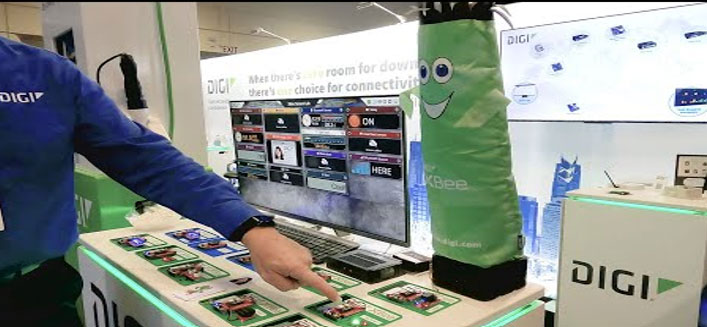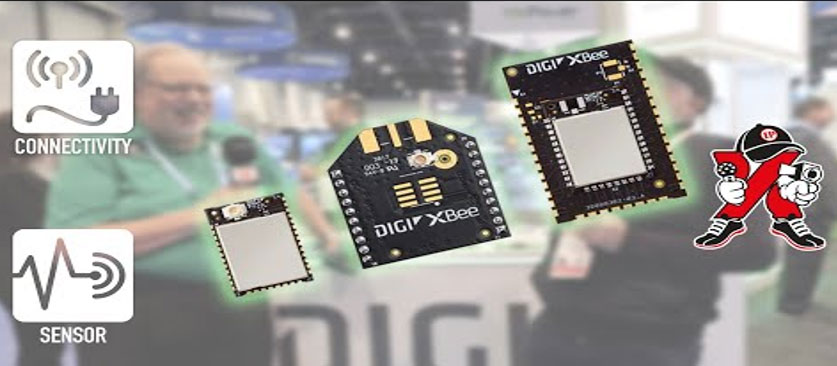The Digi XBee® Sensor Lab is a fun, hands on demonstration of cellular IoT devices for industrial sensing and user interactions. It showcases many of the vast use cases for
Digi XBee cellular modules.
By implementing smart sensors for different commercial and industrial purposes, the XBee Sensor Lab allows attendees to get hands-on with the sensors and see the data changing on a dynamic display in real time. The Sensor Lab was created as a booth demo for trade shows, and provides a hands-on experience for interacting with wireless sensors that illustrates the power of cellular IoT.
The lab integrates a variety of sensors from SparkFun Electronics. They connect directly with Digi XBee 3 Global modules via I2C, which uses MicroPython onboard to accept the raw data, transform it to readings, manage timings, upload to Digi Remote Manager®, configure the XBee and provide resiliency.

Current devices measure air quality, distance, location, accelerations, heart rate, compass heading, RFID tags, keypad entry, light, loudness, soil moisture, weight, SMS display, relay actuation, performing Bluetooth® beaconing and reading Bluetooth sensors. Data is sent via Digi Remote Manager APIs to a web application that displays all the data on a “steam gauge” style dashboard created by our team in Logroño, Spain.
The lab demonstrates the flexibility and fast time-to-market for Digi XBee 3 Cellular-based IoT solutions, and the range of sensing/actuation that the Digi XBee 3 line can accomplish on its own. Things you can hold in your hand and interact with are the most engaging. The lab provides a great way to connect with potential users, and lets them experience all the possibilities of cellular IoT for themselves.

The Digi XBee Sensor Lab also created an open-source framework for driving a variety of SparkFun’s and other manufacturer’s sensors directly from XBee modules themselves, using the module’s onboard MicroPython programming environment. SparkFun supported the XBee Sensor Lab by creating MicroPython-compatible libraries for many of their Qwiic-based sensor boards — greatly speeding our development process.
SparkFun Collaboration
SparkFun products are well loved by individual makers and engineers. They drastically shorten development time and, by taking care of low-level electrical and software requirements, allow developers to focus on creating great applications for real users. SparkFun is an excellent partner for Digi International because both companies shine at lowering engineering costs and improving time to market.
Together, the two companies offer compete support for the full prototype-to-production product lifecycle. SparkFun excels at helping device developers work quickly using proven hardware and software specifically designed for ease of use. Digi International’s wireless and embedded products also lower engineering time and costs, speeding products into revenue-generating production for solutions that easily scale into the tens of thousands and beyond. The two companies have been working together informally for decades, with SparkFun producing some of the most popular third-party hardware for Digi’s XBee module line. Digi in turn has relied on SparkFun to distribute its products to makers, students and engineers with detailed information, software examples, hookup guides and community support.

Recently, SparkFun collaborated with Digi to update and improve SparkFun’s most popular XBee development boards and adapters. This new line of hardware complements SparkFun’s nearly 20-year legacy of creating essential adapters and development tools specifically for the XBee line. SparkFun also created a new Digi XBee 3 kit and a Digi XBee Cellular kit to help new users create their first connected devices in under an hour.
SparkFun's Qwiic Connect System quickly interfaces Digi XBee modules with sensors, displays, relays and more. Creators love it because it eliminates wiring errors and does not require any soldering, making it fast and easy to create prototype devices. The connectors are keyed so that there’s no way to install them backwards, and they can be daisy-chained so that multiple sensors and actuators can be used simultaneously by a single XBee. Along with the updated MicroPython libraries, many of SparkFun’s Qwiic sensors now work with XBee right out of the box, providing a brand-new feature set for the entire Digi XBee 3 line. This is a great show of support for the XBee ecosystem’s continuing value.
Use Cases Demonstrated with XBee Sensor Lab
The devices in the Sensor Lab offer plenty of commercial/industrial applications. The noise and vibration sensors can be used to detect maintenance needs in factory equipment prior to failures. RFID, keypads, and motion sensors are all used in access control. Remotely controlled relays can operate a security gate, activate a pump or switch on a fan as the situation requires. GNSS/GPS with accelerometers and Bluetooth beaconing all have a place in asset tracking, letting users know a vehicle or piece of equipment’s location, whether indoors or outdoors.
Distance and weight sensing can be used in inventory control or tank monitoring. Moisture sensors, light sensors, pump control and GPS are all essential to precision agriculture. Bluetooth sensing, beaconing, heart rate monitoring and air quality are all helpful in healthcare settings and eldercare facilities. The dawn of the AI era is driving new use cases as colossal amounts of real-world data will be required to train the next generations of neural networks. In fact we recently added a machine learning based “person sensor” to the lab, with more AI examples on the way.
The XBee Sensor Lab in the Wild
The Digi XBee Sensor Lab easily travels the world, because it can connect anywhere simply by using a global SIM. It provides a great way to educate potential customers. While they enjoy a hands-on sensor session, we get an opportunity to explain how these systems work, the ease of implementation, and the value they can provide in a variety of use cases.

The Digi XBee Sensor Lab has visited:
- Embedded World (Nuremburg, Germany)
- CES Consumer Electronics Show (Las Vegas, Nevada)
- NAMA National Automatic Merchandising Association (Atlanta, Georgia)
- ENTELEC Energy Telecommunications and Electrical Assn. (Houston, Texas)
- DistribuTECH (Texas)
How It Works
A full tour of the XBee Sensor Lab system should be helpful in understanding it. Each environmental sensor connects to the Digi XBee 3 Cellular module using a SparkFun Qwiic cable. The XBee’s onboard MicroPython environment processes the incoming information and uses cellular LTE to upload it over a secure Internet connect to Digi Remote Manager, where it is stored as a standardized data stream. The custom dashboard application takes advantage of Digi Remote Manager’s comprehensive API to read in the real time data for display.

Components
Here are the components used in the Digi XBee Sensor Lab system, including the full cellular setup, the sensors, the custom enclosure created for each device, and the MicroPython code driving all these applications. Use these resources to get started building your own!
More Events and Learning Opportunities
Be sure to check out our Events page to find out where the Digi XBee Sensor Lab is traveling next. We’re also planning to offer XBee Cellular workshops to a select group of current and future customers, including training on MicroPython, Bluetooth and Digi Remote Manager, to use with the Digi XBee 3 Cellular as an IoT solution. If you’re interested in the workshops, contact Digi Sales for more information.
Interested in building devices like the Digi XBee Sensor Lab’s? All the code is available open-source on GitHub. Grab your own SparkFun Digi XBee Cellular Kit to start creating connected devices using SparkFun’s line of Qwiic sensors and actuators. Be sure to let us know what you built!
Next Steps